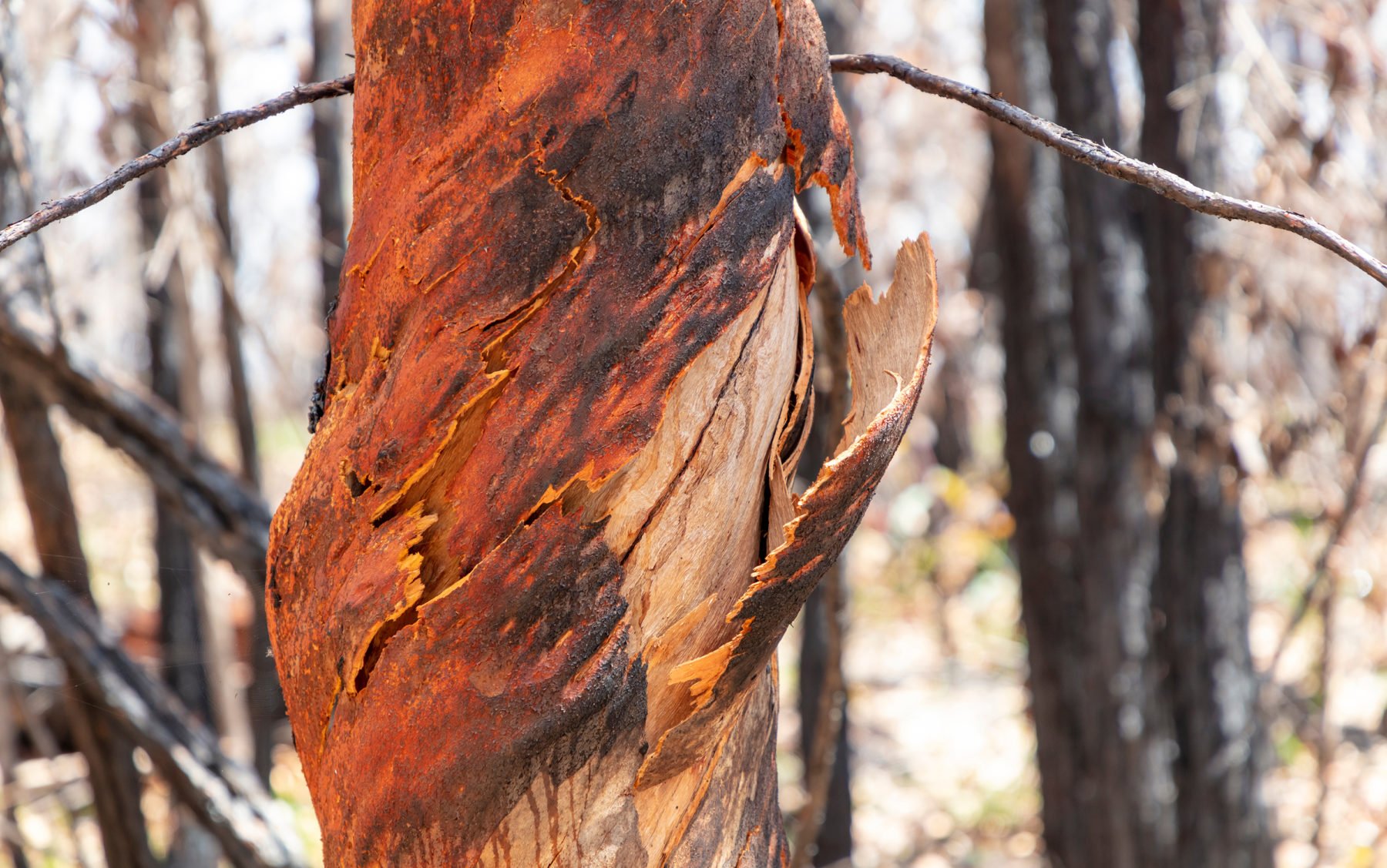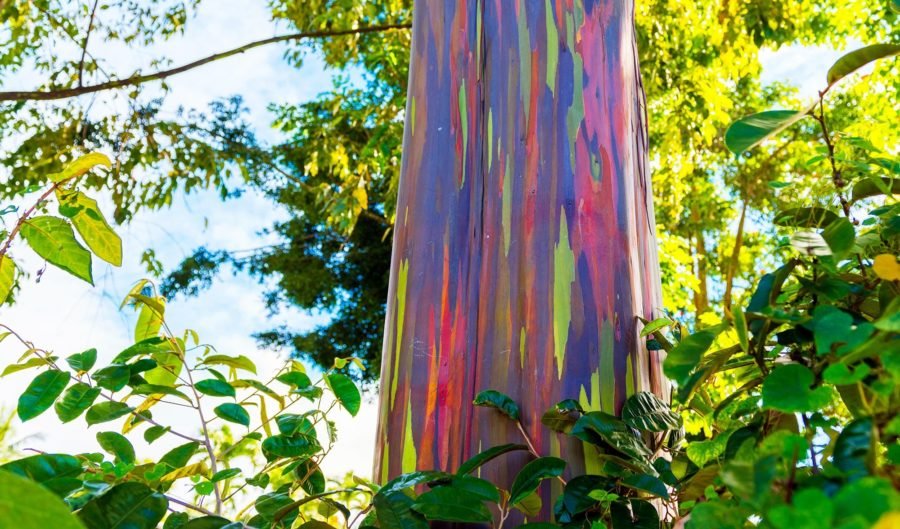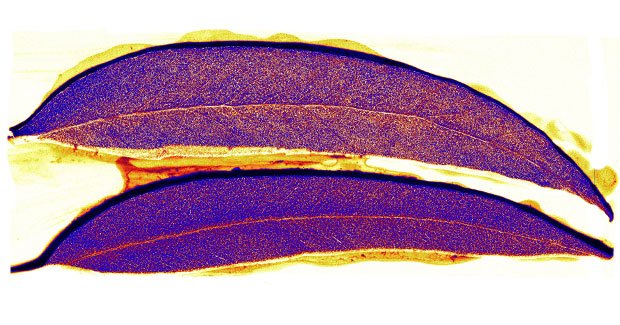On the mainland, just over a million hectares of gum trees (that’s the size of some entire countries, including Belgium and Brunei) achieved the UNESCO World Heritage Commission’s nod to become the Greater Blue Mountains Heritage Area in December 2000. Identifying it as ‘a natural laboratory for studying the evolution of the eucalypts’, the submissions underscored the fact that ‘the largest area of high diversity of eucalypts on the continent is located in south-east Australia’. The Greater Blue Mountains World Heritage Area, they said, ‘includes much of this eucalypt diversity’.
As Christmas 2001 came on, as the first iteration of Gum found its shape, the countryside and its eucalypts were, as the novelist David Foster put it, ‘in heat’, waiting for ‘the kind intercession of Jupiter’s thunderbolts; dry storms over dry forests’. On 3 December 2001, a huge storm formed. It dropped buckets of rain and hail over the coast north of Sydney. Across the parched Blue Mountains, it threw down 17 lightning strikes, and pretty soon trees were alight.
By three in the afternoon, fires were burning across five areas, and the Rural Fire Service had declared Section 44 (RFS Act) emergencies across many fire districts. For three weeks, fires burnt across the mountains and around Sydney. Some were contained; some were fought; some, under fairly calm weather conditions, were left to burn. No houses or people sat in their paths – there were only trees and their wildlife.
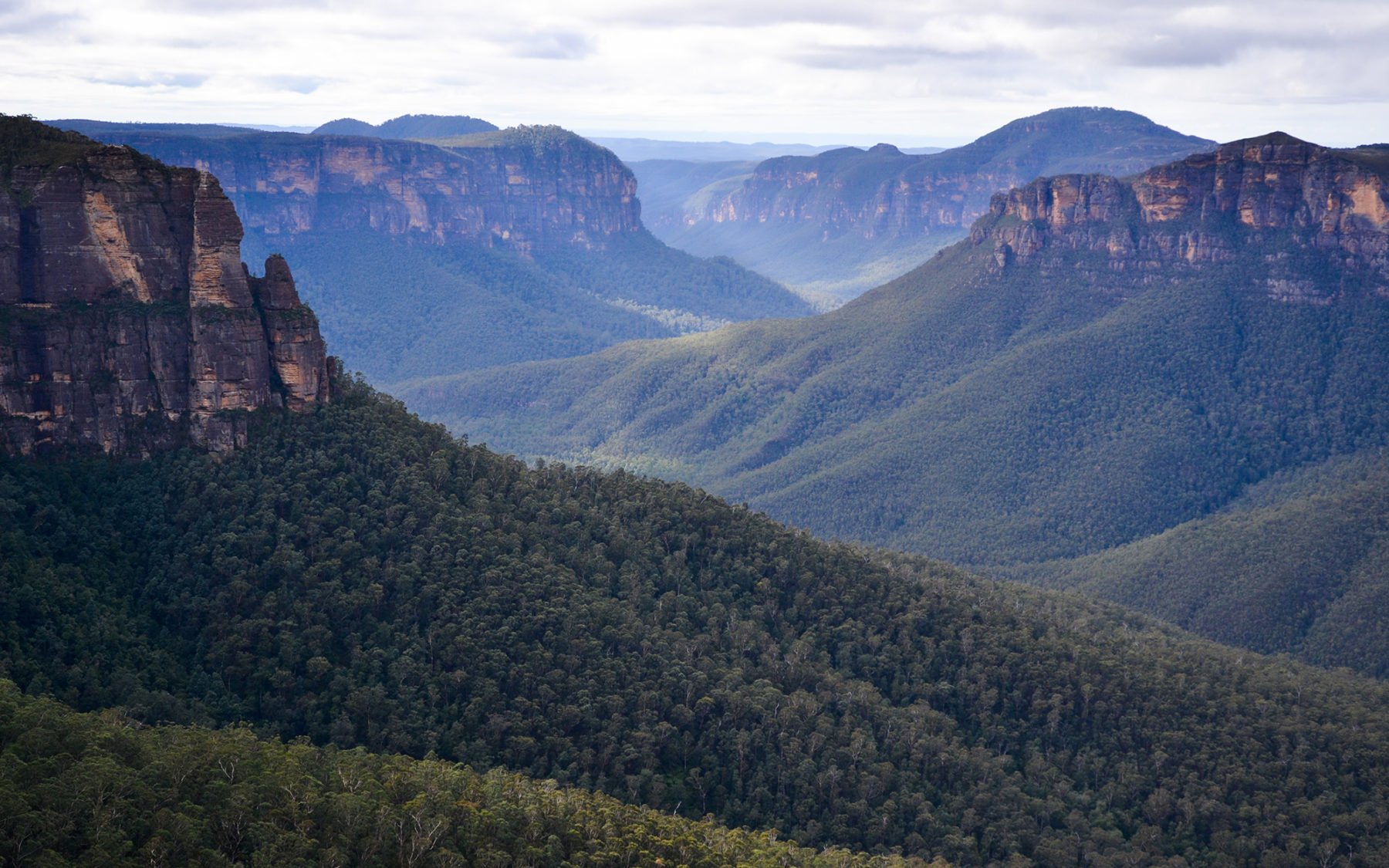
Lightning, which mostly starts fires during the summer, can do several things to a tree. It can burn off a strip of bark, down the length of the trunk, injuring the tree’s internal tissue and its roots. It can kill an upper trunk and branches outright, while the rest of the tree stands unaffected. Sometimes, although there’s no apparent damage, the tree will die months later – again, from internal injuries. ‘Cold lightning’, which strikes at 32 000 kilometres per second, can make a tree explode. ‘Hot bolts’ – which strike at 14 000˚C – will make an entire tree burst into flame. Certain trees, it seems, are more prone to lightning strikes than others – some people suggest it’s the level of oil they contain; others the way their bark reacts to heat.
Australia has always been carved into patches by fire. In Fire Country (2020), Victor Steffensen explains that most of Australia’s vegetation ‘has developed in a perfect way to encourage the right fire for the soil and country it lives on … It is amazing how Mother Nature has created the balance of no-fire and fire-dependent systems to provide tolerance and courtesy between them through fire’. Fire seasons span different lengths of time at different times of the year in different places; those long, dry weeks when the multicoloured semicircles of fire danger signs flick their needles into the red of Extreme (or, after 2009, the alarmingly cross-hatched brightness of Catastrophic) and sit, locked there, for days. Any story about this continent, its ecology, its history and its gum trees, must talk about the unavoidable interconnection between Australia and fire.
There’s a dangerously cosy relationship between eucalypts and fire. Most of these trees have bark that will protect them; fire can produce the perfect situation for the eucalypts to germinate; and all but a handful of their species carry lignotubers, new shoots that can push their way out through superficially burnt grass or the trunk. Plus they drop between a third and a half of their leaves annually, with their ‘peak drop’ in late spring, early summer – perfect fire-season time in many places. The trees’ litter dries out and covers the ground as ready fuel (3 centimetres of leaf litter can cause a conflagration equivalent to one fuelled by a centimetre of refined gasoline) – and most trees have the kind of open crowns that can generate an enormous updraught in next to no time.
Some gums have shreds of hanging bark – stringybark or candlebark ‘filigree strips’ – that dangle like firebrands and can be carried 10, 20, up to 40 kilometres ahead of a firefront by the wind to spark new flames. Others carry high levels of flammable oil in their foliage and their twigs.
In some species, the bark that’s supposed to protect the tree carries fire straight up into the canopy of the forest, creating the most volatile of fires, a crown fire. Other species can cause fires to behave like huge whirlwinds, spinning furiously and sucking (at about 100 kilometres an hour) leaves, sticks and embers metres up into the air, where they disintegrate in a great gassy explosion that you can hear miles away. They have been known to suck every speck of soil off a sizeable piece of ground.
(These examples, this knowledge, pre-date the more recent summer of 2019–2020, which will necessarily change – and rewrite – parts of this story.)
Eucalypts are designed to survive deteriorating soils and unreliable water, which makes them (as it has been bluntly put) ‘fireweeds’. They can pull nutrients out of the ground and direct them straight to new, post-burn growth. Opportunistic, they’ll burn readily, greedily and gratefully. Perfectly suited to survive fire, they often require it; they often thrive in it.
Opportunistic? The eucalypts, said David Foster, ‘are cunning – they’ve got the situation sussed. In winter, they won’t burn; two weeks later, you’ll find yourself in high fire danger and you can’t burn. The fuel builds up and builds up – and they seem to work the climate well so they don’t burn when it’s convenient to you’. He knew the eucalypts: he fought them for his local rural fire brigade – the brigade in Wingello in the Southern Highlands of New South Wales, where one firefighter was killed and five others horrifically burnt in 1998 in an explosion of grey ironbark, white gum and white stringybark. Which made him ‘hate stringybark with a Passion’.
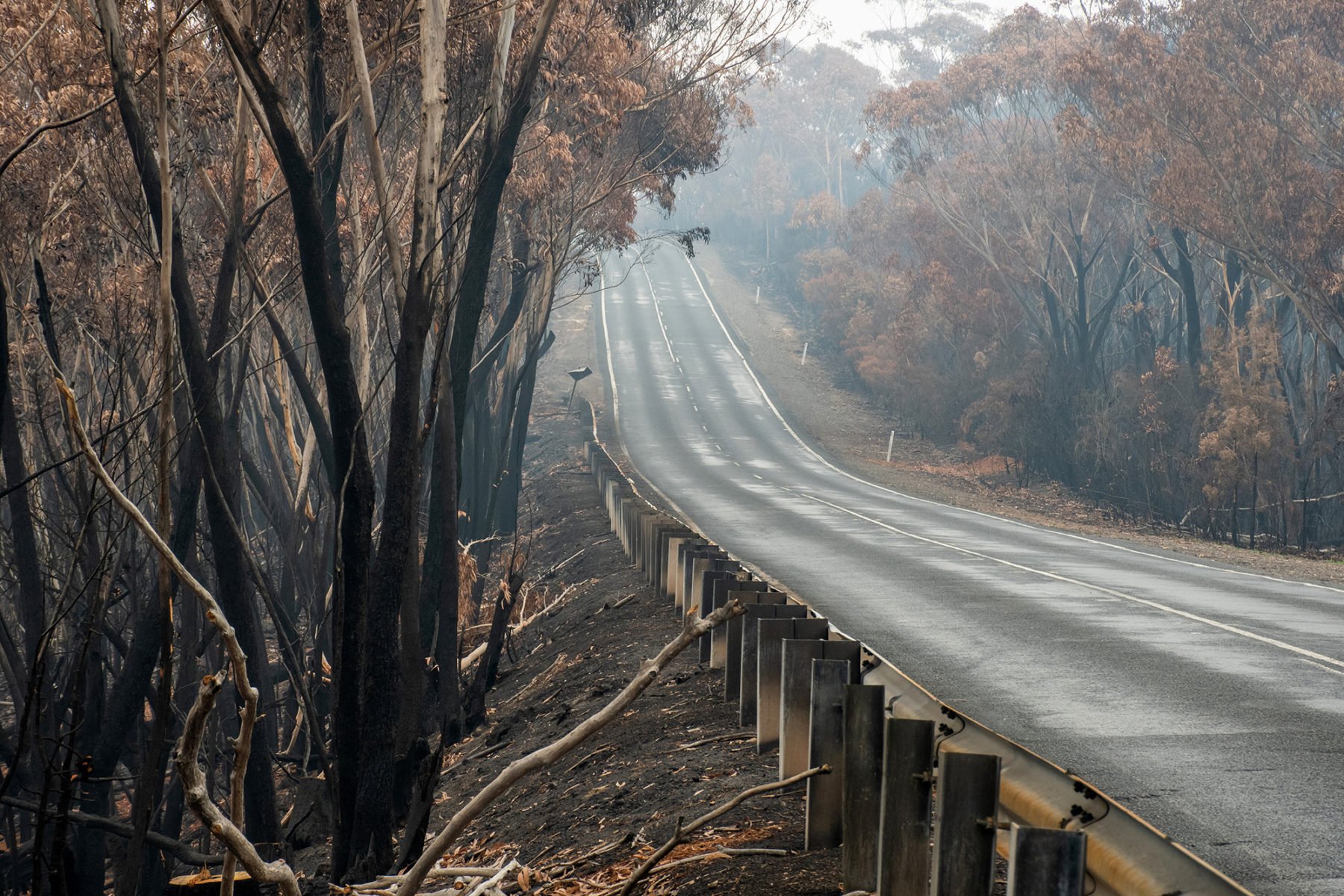
The oldest known eucalypt fossils date back 51.9 million years and were found not in Australia, but in Patagonia, as part of the supercontinent Gondwana. In Australia, they coexist in the fossil record alongside fossil charcoal deposits, suggesting a long coexistence with fire. The smell of burning eucalyptus leaves has been in Australia’s air for millions of years. Between roughly 5 and 2 million years ago, when Australia’s vegetation was already ‘essentially similar to what it is today’, the climate changed again. Drier conditions set in: the rainforest retreated towards the continent’s coast and the eucalypts, fearsome and increasingly fire-prone in the new dry environment, expanded in its wake.
In the next geological era – still running as recently as 10 000 years ago – everything the eucalypts needed to explode into the vast number of species and locations they would occupy was in place. The landscape was passing through periods of great aridity; the climate was melding into more predictable seasons; and fires were well and truly burning. Australia’s First Nations had also begun to influence both the landscape and what it could produce through the way they managed and shaped it with fire. ‘Firestick farming’ – as Australian archaeologists, scientists and other researchers would later call this practice – had begun.
As the environment changed and changed again, a new, precise and fragile interdependence was established between eucalypts and fire. Most gum trees need to burn at some stage during their seed-bearing life. Some need heat to release their seeds (a risky business, timing the release of a capsule that is smaller than a centimetre and has to protect the seed ‘sufficiently long in the holocaust of raging crown fires’). Some – it was more recently found – need smoke to activate them. Most need ash to provide a clear, soft bed for their seedlings, free from any competing plants. They require, and promote, fire. And they can accommodate it. Even in the worst bushfire, a eucalypt forest should only risk a tiny fraction of itself as fuel – 95 per cent of its biomass locked away in its trunks, which might char but should not be consumed, even during the most intense fire.
They are supposed to accommodate the very severity that they encourage.
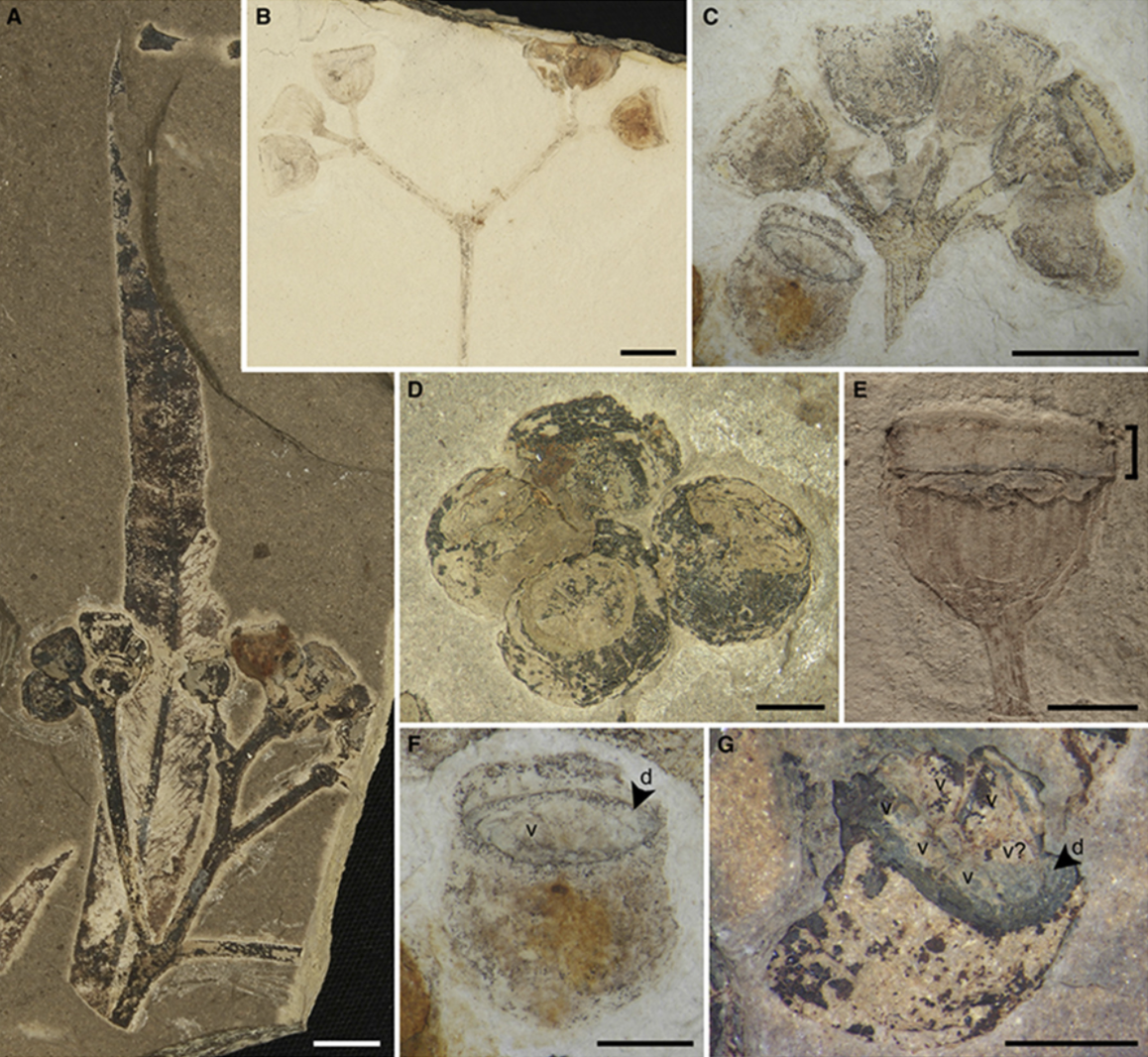
For all that those people carving out Australia’s first British colonies had pined for the annual rebirth of the northern hemisphere’s deciduous trees, the rebirth from lignotubers and from carpets of sun-hungry young seedlings is even more miraculous. No post-bushfire story could be told without shoots sparking from black stumps, the fluffy bright green of their first new leaves against grey soil, against the memory of trees that had looked dead in the black-and-red of the fire. As the artist Rosalie Gascoigne described it in the 1990s: ‘After the flames had died down it was amazing to see what was standing and what was burnt to a cinder. All of the gums looked shattered, but you get those blue-green shoots after, it’s very gentle’.
Every foreign ship that skirted the edge of Australia, from Abel Tasman’s through to Captain Cook’s, and on further to those carrying the waves of people who would land and settle and explode Australia’s imported population – all had noted the prevalence of fire along the continent’s edge. Cook, after his first sighting of the coast, had written in his diary, ‘in the afternoon we saw smoke in several places by which we knew the country to be inhabited’. His New Wales, he had said, was ‘The Continent of Smoke’; ironic, perhaps, given that at least some of this smoke was the messages about his ship’s coming, passing along Australia’s east coast between First Nations.
The First Fleet’s Governor Phillip arrived 18 years later and announced that you couldn’t go as far as a mile into this place without seeing a tree blackened up its trunk. Yet it wasn’t until two years after that, in 1790, that the First Fleet endured a summer with the temperature surging through the forties and a wind pouring from the north-west as if from an oven. Even then, when it was so hot that birds and flying foxes died midflight and the white men collapsed onto their beds, Sydney did not burn: a grass fire that bore down hard on the settlement could be easily routed.
Two years later, though, with regular Indigenous burning regimes now much more disrupted, the bushfire season saw the space around Sydney catch ‘everywhere on fire’. And in 1797 there was such a conflagration that chain gangs of convicts were promised a pardon if they would stand and battle the blaze. They fought through the night, shackled together, beating at the flames with boughs of eucalypt branches. By morning, the fires were contained, and the men were freed.
In the northern part of the world, where all those men came from, fires were often loaded with as much mythology as the forests were. In England the fires, like the land, had been domesticated. Stories of fires were about hearths and warmth and controlled flames, but large fires were indicative of the Apocalypse, the end of the world. To a Eurocentric mind, fire meant one thing: big, bad, destructive danger. To be avoided at all costs. As one of the governor’s officers put it, attempting to survey the recently colonised Blue Mountains in 1814, ‘the mountains have been fired; had we been on them we could not have escaped; the Flames raged with violence through thick underwood …’ The burnt trees, he complained, ‘tear our clothes to pieces, and make us appear as Natives from the black dust off them’.
The idea that fire might be a positive thing for the land and its vegetation, a constructive thing, a necessary thing, was as impossible to this colonial mindset as the idea that trees might have grey-green leaves that hung on all year and still be considered beautiful. To suggest that the continent’s First Nations had sophisticated patterns of fire use to control their vegetation, to keep the fires themselves in check, did not occur to many colonial minds. Yet from the earliest times of settlement’s disruption, some observers had proposed that there might be a link between the two. Drawing together the high rate of fire, and that sparsely-treed park-like appearance the country running out to the mountains had first presented to its European arrivals, the NSW Surveyor-General Major Thomas Mitchell had commented that ‘fire, grass, kangaroos and human inhabitants seem dependent on each other for existence in Australia, for any one of these being wanting, the others could no longer continue’. During his own time moving through this country, he had seen that ‘the omission of the annual periodical burning by natives, of the grass and young saplings, has already produced in the open forest lands nearest to Sydney, thick forests of young trees where, formerly, a man might gallop without impediment’.
Writing after the 2019–20 fire season, Bruce Pascoe, of Bunurong and Yuin heritage, recalled:
… late one afternoon, retreating from a patch of bush on a ridge as I saw a wind change turn a fire back towards me. I looked at a group of massive trees before I left. This was a remnant of the original Aboriginal forest. The trees were massive, but there were few of them. Somehow the loggers had ignored this patch: perhaps this was because they were mostly angophora and bloodwood. Or it could have been because they were atop a ridge and had been writhen by the wind, the trunks and limbs twisted into shapes the sawmiller cannot abide.
Anyway, I felt sure I would see these trees the next day even though the fire had begun to roar up the mountain. The trees did survive but all the smaller regrowth forest was smashed; some of it had completely disappeared. The vindication of Aboriginal forest method was self-evident. Their soaring might.
On 6 February 1851, just three years after Mitchell’s observation of those ‘thick forests of young trees’, bushfires swept through Victoria and showed their potential magnitude to the continent’s colonists for the first time. ‘Black Thursday’, they were called, and one artist who painted them commented that ‘in the town of Kilmore the inhabitants thought the end of the world had come, and clinging to one another bade each other, as they supposed, a last farewell’. So fierce were the fires that people all the way across Bass Strait in Tasmania watched the sky darken, while leaves charred to ash, their veins still visible, floated across the ocean from the mainland and fell from the sky. Black Thursday was followed by Red Tuesday (1 February 1898), Black Sunday (14 February 1926), Black Friday (13 January 1939: a popular fire – enterprising aeroplane owners offered sightseeing flights over the flames, for 30 shillings, from Essendon airport), Black Tuesday (7 February 1967) and Ash Wednesday (16 February 1983). Not to mention the enormous fires in 1919, 1951, 1968, 1977 and 1991 that didn’t get names; blazes that blackened 15 per cent of the entire continent in 1974–75; the incendiary enormity of the 2019–20 season, and so many other fires besides.
The kinds of names fires were given remained constant, but colonial Australia’s approach to fire has historically rollercoastered from foresters convinced that fire could and should be eliminated from the Australian environment, to foresters convinced that they themselves should fire patches of the country every so often. On the whole, fire has been ‘the enemy’. Farmers and pastoralists tried to restrict it by getting rid of their trees. Anti-fire foresters argued that there was ‘not a shadow of a doubt that [forests of gum and wattle] can be as
completely protected from fire as the average house in the city’. It was ‘solely a matter of organisation’. A character in HA Lindsay’s 1959 children’s novel The Red Bull suggested that the best thing for controlling fire would be to clear out the pyrophitic native forests and plant incombustible ‘green belts’ of oak and ash and hickory in their place.
As recently as 1937, the pioneering forester Max Jacobs had assured other foresters that ‘complete fire protection is not impossible or impracticable, but an inevitable development’, while his predecessor as principal of the Forestry School had said flatly that the belief that ‘a fire through the bush is a good thing [has] no solid basis in fact’. It was 1947 before a climatologist uncovered ‘immutable geographic circumstances that make large fires so routine a phenomenon in Australia’, and 1981 before evidence for the role of fire in the development and maintenance of Australia’s plant population was systematically examined by science for the first time. The recent reintegration of and insistence on Indigenous burning practices in so many different parts of the continent’s landscape is an important and revolutionary return.
This is an edited extract from Gum: The story of eucalypts and their champions by Ashley Hay, published by NewSouth.
